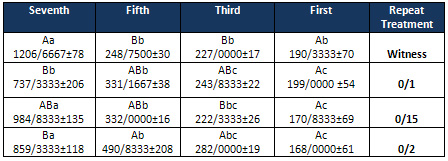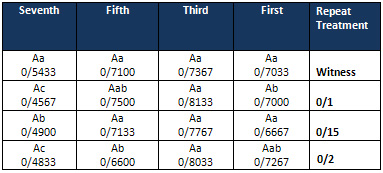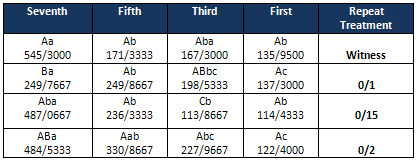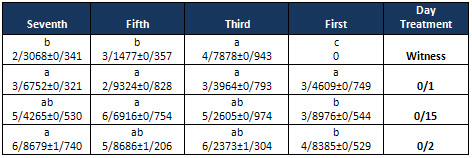|
|
 |
| ............................................................. |
|
|
| ........................................................ |
| From
the Editor |

|
Editorial
A. Abyad (Chief Editor) |
|
|
|
|
........................................................ |
Original
Contribution / Clinical Investigation
|





|
<-- Jordan, USA -->
Herpetic
Eye Disease and Glaucoma Related Diagnosis
[pdf version]
C. Dan Earley, Amal M Althawabi,
Paul R Cotran, Sarkis H Soukiasian
<-- Turkey, Lebanon, Australia -->
Cholelithiasis
may also be a consequence of metabolic syndrome
[pdf
version]
Mehmet Rami Helvaci, Mursel Davarci,
Orhan Veli Ozkan, Ersan Semerci, Abdulrazak
Abyad, Lesley Pocock
<-- Iran -->
SUMO1 pseudogene
3 (SUMO1P3) expression in human gastric cancer
and its clinical significance
[pdf version]
Hamid Reza Baradaran-Ghahfarokhi, Habib Malekpour,
Ehsan Nazemalhosseini Mojarad,
Hamid Asadzadeh Aghdaei, Majid Asadi-Samani,
Azar Baradaran
<-- Iran -->
Decoy Cell
Viruria in Kidney Transplant Patients. Does
it correlate with Renal Function?
[pdf version]
Akram Abedi, Mojgan Mortazavi,
Omid Mirmosayyeb, Shahram Taheri,
Nooshin Afsharmoghadam,
Majid Asadi-Samani, Shahram Sajadieh,
Azar Baradaran
<-- Iran, Austria -->
To determine
how frequently pregnant asthmatics are sensitive
to food and inhalation allergens
[pdf version]
Nasrin Fazel, Michael Kundi,
Erika Jensen-Jarolim,
Isabella Maria Pali-Schöll,
Asghar Kazemzadeh, Mojtaba Fattahi Abdizadeh,
Habibollah Esmaily,
Roya Akbarzadeh, Raheleh Ahmadi
|
........................................................
Special Education Feature
........................................................
International Health
Affairs
|
Chief
Editor -
Abdulrazak
Abyad
MD, MPH, MBA, AGSF, AFCHSE
.........................................................
Editorial
Office -
Abyad Medical Center & Middle East Longevity
Institute
Azmi Street, Abdo Center,
PO BOX 618
Tripoli, Lebanon
Phone: (961) 6-443684
Fax: (961) 6-443685
Email:
aabyad@cyberia.net.lb
.........................................................
Publisher
-
Lesley
Pocock
medi+WORLD International
11 Colston Avenue,
Sherbrooke 3789
AUSTRALIA
Phone: +61 (3) 9005 9847
Fax: +61 (3) 9012 5857
Email:
lesleypocock@mediworld.com.au
.........................................................
Editorial
Enquiries -
abyad@cyberia.net.lb
.........................................................
Advertising
Enquiries -
lesleypocock@mediworld.com.au
.........................................................
While all
efforts have been made to ensure the accuracy
of the information in this journal, opinions
expressed are those of the authors and do not
necessarily reflect the views of The Publishers,
Editor or the Editorial Board. The publishers,
Editor and Editorial Board cannot be held responsible
for errors or any consequences arising from
the use of information contained in this journal;
or the views and opinions expressed. Publication
of any advertisements does not constitute any
endorsement by the Publishers and Editors of
the product advertised.
The contents
of this journal are copyright. Apart from any
fair dealing for purposes of private study,
research, criticism or review, as permitted
under the Australian Copyright Act, no part
of this program may be reproduced without the
permission of the publisher.
|
|
|
| July 2017 - Volume
15, Issue 5 |
|
|
Gum Sisymbrium irio
effect on the quality attributes of baguettes
Leila Azadi
Mohammad Hojjatoleslamy
Hooman Molavi
Department of Food
science and technology,
Islamic Azad University,
Shahre Kord Branch,
Shahre Kord,
Iran
Correspondence:
Leila Azadi, Mohammad Hojjatoleslamy
Department of Food science and technology,
Islamic Azad University,
Shahre Kord Branch,
Shahre Kord,
Iran
Email: mohojjat@iaushk.ac.ir
|
Abstract
In this study,
gum Sisymbrium irio at different levels
of Control, 1/0, 1/5 and 2/0 percent (w,
w) and wheat flour, in loaf bread and
its impact on the quality attributes including
technological features, colours and staling
throughout the day, and various storage
mechanisms were evaluated. The results
of the evaluation of technical features,
showed that gum Sisymbrium irio increased
humidity, reduced stiffness and reduced
volume compared with the control bread.
By increasing the hold time, stale bread
and buns control treated with different
levels of gum Sisymbrium irio significantly
increased, shelf life.
Key words: Gum Sisymbrium irio,
loaf bread staling, colorimetric
|
In multi-phase systems such as bread dough, stable,
hydroxypropyl methyl cellulose emulsion is maintained
during baking. The hydrocolloid films, the phase
boundary between gas bubbles, are created and
provide stability of cells in the gas expansion
and other changes in the process. When the temperature
rises during baking, hydroxyl propyl methyl cellulose,
hydrocolloid gels formed through the interaction
of the chain and create a temporary network. This
will boost the dough during the expansion and
reduction in volume is prevented. The gel also
acts as a barrier against loss of moisture and
flavor without any adverse effect on soft tissue
of bread ( Appelqvist et al. 1997, Armero et al
.1997 ). The type and amount of hydrocolloids
in bread depends on the type of bread and also
properties of the flour used. Usually hydrocolloids
are used in loaf bread for tissue recovery, and
to strengthen the gluten network, creating a smooth,
uniform consistency and to delay staling. Carboxy
methyl cellulose (CMC) with an average size is
more consistent with the gum flour and has been
added to the dough in along with other components
such as sugar, so more water is absorbed. Some
types of carboxy methyl cellulose have very good
water holding capacity but relatively poor solubility,
Water holding capacity in bakery products is very
important. Carboxymethyl cellulose in food, increase
efficiency, to delay staling and also increase
product acceptance by consumers and increase shelf
life, Carboxy methyl cellulose is compatible with
other ingredients and bread improvers ( Bell,
DA. 1990 ). Effect of a combination of carboxymethyl
cellulose and hydroxyl propyl cellulose with other
additives such as enzymes and emulsifiers to check
and confirm that the addition of carboxymethyl
cellulose and hydroxyl propyl cellulose improves
the rheological properties of dough and bread
shelf life ( Sarkar et al.. 1995). Xanthan gum
and Locust, studies about the impact on the quality
of bread and colleagues show that this hydrocolloids,
stale bread delay and increased moisture in the
bread crumb has a positive impact on the stability
of the dough and the final product. Meat product
is used to increase the storage period ( Collar.1996
). In relation to the effect of adding gum on
the rheological properties and breadmaking quality
of the research was done and it was found that
gum production to the dough, improves dough stability
during fermentation and specific volume, water
activity increased bread moisture is better preserved
(Brady et al .1985, Selomulyo et al. 2007). In
the study several hydrocolloids with different
chemical structures in loaf bread were observed
and that some of these hydrocolloids are able
to a degree prevent loss of moisture during storage
and speed dehydration of bread crumb reducing
and preventing staling of bread. According to
various researchers, hydrocolloids to conserve
water and to prevent redistribution of bread,
as well as preserving more [brain] volume and
softness gas improves speed and reduces fresh
bread staling. Hydrocolloids in bakery products
can be used as fat replacers. Hydrocolloids, xanthan
and tragacanth effect on the levels of 0/5 and
1/5 on the rheological and sensory properties
of frozen dough from flour as a way to improve
the quality of structural damage caused by freezing
and frozen dough bread waste reduction and tails,
were studied. Effect of guar gum, pectin, alginate,
and xanthan Kapakaragynan looked on wheat flour
paste features and was also studied. They use
Mylugraf which showed that the addition of the
hydrocolloids in quantities of 5/0% and 1% (w
w) improves the properties of dough produced (Kim
et al . 1977). The use of frozen dough bread is
one way of effectively reducing the rate of bread
staling. In this study, the effect of hydrocolloids,
xanthan and tragacanth at two levels: 5/0 and
5/1 percent (w weight based on flour) on the rheological
properties of dough and hamburger buns made from
frozen dough stored (at oC18- for 2 weeks) and
sensory quality were studied. The results of the
study of several hydrocolloid with chemical structures
from different loaf bread showed that some of
these hydrocolloids are capable of loss of moisture
during storage of bread and speed dehydration
bread crumb, reduce the staling prevent (Guarda
et al , 2004 , MacRitchie et al- . 1973). The
results of Rojas and colleagues showed that the
forming properties of wheat starch paste greatly
improved by adding hydrocolloids. In addition,
in several studies of gum as a fat replacer, is
used to replace gluten and source of dietary fiber
(Appelqvist et al. 1997). Effect of hydrocolloids
alginate, xanthan and hydroxy propyl methyl cellulose
the rheological properties of dough and bread
quality, were examined. The results showed that
the addition of these substances increases during
fermentation dough stability and increased specific
volume and holding., Also, adding the hydrocolloids
reduces the hardness of the bread crumbing (Selomulyo
et al . 2007). They found that all hydrocolloids
are able to hold moisture loss during crumbing
of bread and reduce the rate of water loss and
moisture to increase the bread crumb ( Guarda
et al , 2004).
In this study, Sisymbrium irio Golestan Mohammadi
was purchased from flour factories. The use
of dry yeast factory production FARIMAN Mashhad.
In Tables 1 and 2, respectively Sisymbrium irio
characteristics of flour and gum used is listed.
Gum prepared Sisymbrium irio
Sisymbrium irio was 40 ° C for 4 hours in
the water, after passing through the filter,
the material after drying (gum) was added to
breads and cakes.
Baking bread
Bread baguette in the bread industry unit according
to Lee, who, has been mentioned in Table 3,
were produced. After sieve weighing the dry
ingredients for making bread they can be mixed
together. The yeast suspension in water with
a temperature of 35 ° C containing 5.0%
sucrose for 10 minutes to activate the yeast
cells was prepared, and was added to the above
materials. Finally, the remaining water was
also added to the formulation. All compounds
were mixed at 1 mixer for 10 minutes. Pulp obtained
from the following 4 treatment groups were prepared
so that all of their components except Sisymbrium
irio gum, were considered constant.
Treatment 1: No gum Sisymbrium irio
Treatment 2: containing 1.0% gum Sisymbrium
irio
Treatment 3: 15/0 percent gum containing
Sisymbrium irio
Treatment 4: 2.0% gum containing Sisymbrium
irio
90 gram pulp were split into pieces and shaped
in the form, respectively. Templates in the
fermentation chamber temperature and relative
humidity of 85% C ° 38 were placed for 60
minutes. Action Bake for 25 to 30 minutes at
a temperature C ° 240 industries in the
oven with steam injection was performed. After
baking, breads were extracted from the mold,
and cooled at room temperature for half an hour
and then were packed in polypropylene bags until
tests were kept at the right temperature.
Table 1: Wheat and Flour Quality Characteristics
in terms of dry matter

Statistical analysis
Statistical tests based on completely randomized
design with three treatments and three replications.
First, by analyzing the variance in the comparison
test Duncan means of a significance level of
5% was conducted to evaluate the significance
of the results. Statistical analysis using Excel
software and SPSS version 21 was conducted.
Table
2,
shows
that
the
control
samples
had
the
sample
had
the
highest
humidity
and
low
moisture
content
in
the
sample
was
found
to
contain
1.0
per
cent
Gum
Sisymbrium
irio.
Eskandari
and
his
colleagues,
as
well
as
Yarmand
and
Ardebil's
similar
results
were
reported
(Yarmand
et
al
.
2005,
Pouresmaeil.
2010).
Russell
et
al.,
Guarda
and
colleagues
and
Pooresmaeel
also
had
similar
results
from
adding
hydrocolloids,
xanthan
gum,
sodium
alginate,
Kapakaragynan,
hydroxypropyl
methyl
cellulose
and
guar
and
increase
their
concentration
acquired
(Bouaziz
et
al
.
2010,
Guarda
et
al
.
2004).
Table
2:
Increase
in
moisture
content
compared
to
control
samples

Volume
Gum
Sisymbrium
irio
at
1/0,
15/0
2/0%
on
bread,
reduced
size
compared
with
the
control
bread.
Sisymbrium
irio
gum
may
reduce
the
production
of
cavities
in
bread.
This
reduction
could
be
due
to
reduced
capacity
as
a
result
of
reducing
the
amount
of
gas
in
the
dough
gluten.
The
results
obtained
in
the
investigation
(
-Bazayz
and
colleagues
in
2010),(Garmyla
and
colleagues
in
2011),
as
well
as
liquids
.
Table
3:
Gum
Sisymbrium
irio
at
1/0,
15/0
2/0%
on
bread,
reduced
size
compared
with
the
control
bread

Firmness
Hardness,
resistance
to
deformation
crumb
texture
is
a
characteristic
that
in
most
cases
is
used
to
assess
staling
(212)
.
On
the
seventh
day
the
most
difficult
to
control
bread
and
the
least
amount
of
hard
bread
with
2.0
percent
in
the
first
batch
was
awarded
Sisymbrium
irio
gum.
Retrogradation
is
a
function
of
the
difficulty
and
thus
increases
with
increasing
difficulty
retrograde.
Table
4:
Compare
the
average
impact
factor
gum
Sisymbrium
irio
difficult
and
time
consuming
bread

Continuity
Back
to
the
flexibility
of
the
tissue
and
its
continuity
depends
on
the
initial
state.
Gum
Sisymbrium
irio
may
cause
damage
to
the
gluten
network
structure
and
causes
reversal
to
the
original
state.
Therefore,
the
addition
of
gum
Sisymbrium
irio
reduced
coherence
factor
in
bread
samples
containing
gum
Sisymbrium
irio,
against
controls.
Therefore,
by
increasing
the
gum
and
over
time,
decreases
the
staling.
Table
5:
Compare
the
average
impact
factor
gum
Sisymbrium
irio
and
time-consuming
integration
of
cake

A,
B
and
C
show
a
significant
difference
between
the
rates
on
different
days
and
a,
b
and
c
indicate
the
presence
of
significant
differences
in
different
treatments
(0/05>
p).
The
resinous
gum
Appendix
3
can
be
downloaded
by
examining
the
sample
containing
the
resinous
gum
Sisymbrium
irio
at
intervals
less
than
the
control
sample
immediately
after
cooking.
Resinous
and
other
parameters
of
texture
analysis.
This
parameter
assists
to
digest
food
and
prepare
it
for
swallowing.
Table
6:
Compare
the
average
impact
factor
of
gum
Sisymbrium
irio
and
time
Smghyt
bread

A,
B
and
C
show
a
significant
difference
between
the
rates
on
different
days
and
a,
b
and
c
indicate
the
presence
of
significant
differences
in
different
treatments
(05/0>
p).
Image
Processing
Compared
with
the
control
of
bread
crumb
with
gum
and
increased
levels
of
color
which
was
darker.
Since
the
Maillard
reaction
is
not
involved
in
making
the
bread
crumb
color,
dark
bread
crumb
is
likely
caused
by
gum
Sisymbrium
irio,
according
to
the
results
obtained
by
Pooresmaeel
due
to
compression
of
the
grain
tissue
due
to
decreased
volume,
and
gum
gel
formation
Sisymbrium
irio
is
(Bouaziz
et
al
,
2010).
Table
7:
Compare
the
average
impact
factor
of
gum
Sisymbrium
irio
and
time-consuming
brown
bread

a,
b
and
c
indicate
the
presence
of
significant
differences
in
different
treatments
(05/0>
p).
Results
Table
(8)
,
shows
that
in
the
control
sample
had
reduced
color
change
over
time,
while
gum
samples
containing
2.0
Sisymbrium
irio
15/0
and
color
changes
were
observed
with
the
passage
of
time.
Table
8:
Compare
the
average
impact
factor
of
gum
Sisymbrium
irio
and
time-consuming
color
variations
in
bread

a,
b
and
c
indicate
the
presence
of
significant
differences
in
different
treatments
(05/0>
p).
Evaluation
of
Porosity
Results
Tables
(7)
to
(8)
obtained
from
analysis
of
texture
images
show
that
by
increasing
the
pore
size
it
reduced
Sisymbrium
irio
gum
that
can
be
difficult
due
to
reduced
volume
and
increased
bread.
The
mean
pore
diameter
of
the
holes
indicate
the
area
is
reduced,
decreasing
in
height
and
diameter
of
these
changes.
These
results
are
consistent
with
the
results
of
research
of
S.Han
and
colleagues
(Ozkoc
et
al
.
2009).
In
addition,
during
the
leavening,
the
bubbles
that
are
produced
during
the
mixing
within
the
dough
expand
their
gas
production
by
yeast.
Thus,
the
stability
of
bubbles
is
most
important
in
that
the
main
cause
of
instability
is
connected
to
individual
gas
cells.
Thick
layer
of
bubbles
on
the
inter
connectedness
of
the
dough
is
reduced
(Volpini-Rapina
et
al
.
2012).
Sensory
evaluation
Bread
properties,
such
as
colour,
aroma,
taste,
are
enhanced
by
increasing
the
gum
Sisymbrium
irio
points
respectively.
Related
to
the
appearance
of
bread
it
is
similar
to
the
results
obtained
in
their
research
confirms
that
Shalin
and
colleagues
(Mettler
et
al
.
1993,
Sidhu
et
al
.
1988).
With
the
increase
in
chewing
ability
bread
with
Sisymbrium
irio,
shows
improvement
and
that
corresponds
with
the
results
of
Guarda
and
colleagues
(Guarda
et
al
.
2004).
According
to
the
results
of
tests
to
assess
the
properties
of
bread,
it
was
found
that
bread
with
1/0
Drsdsmgh
Sisymbrium
irio
gives
the
best
sensory
quality.
Gum
Sisymbrium
irio
in
increased
levels
in
bread
increased
hardness,
cohesiveness,
its
resinous,
elasticity,and
chewiness
.
along
with
cutting
ability,
brightness,
and
reduced
porosity.
Sensory
evaluation
factors
decrease
with
increasing
gum.
Reduced
volume
and
crumb
and
crust
color
darkening,are
the
unfavorable
characteristics
of
the
gum.
It
should
be
noted
that
treatment
with
1.0
per
cent
Gum
Sisymbrium
irio
enhances
the
sensory
properties
of
bread
better
than
the
control
sample.
Acknowledgment
With
special
thanks
to
the
Research
and
Technology
deputy
of
the
Islamic
Azad
University,
sharkord
branch.
1-
Appelqvist
IAM,
Debet
MRM.
Starch-biopolymer
interactions:
a
review.
Food
Rev
Int
1997;
13:
163-24.
2-
Armero
E,
Collar
C.
Texture
properties
of
formulated
wheatdoughs.
Z
Lebensm-
Unters
Forsch
1997;
204:136-45.
3-
Bell
DA.
Methylcellulose
as
a
structure
enhancer
in
bread
baking.
Cereal
Foods
World
1990;
35:
1001-1006.
4-
Bouaziz,
M.
A.,
Amara
,
W.
B.,
Attia,
H.,
Blecker,
C.,
&
Besbes,
S.
(2010).
Effect
of
the_addition
of
de-fatted
date
seeds
on
wheat
dough
performance
and
bread
quality,
Journal
of
Texture
Studies,
41,
511-531.
5-
Brady
PL
and
Mayer
SM,
1985.
Correlation
of
sensory
and
instrumental
measures
of
bread
texture.
Cereal
chemistry
62(1):
70.
6-
Collar,
C.E.1996.
Retrogradation
of
the
starch
fraction
in
wheat
bread.
Food
Science
and
Technol.Int.
2:
323-333.
7-
Guarda
A,
Rosell
CM,
Benedito
C,
Galotto
MJ
(2004)
Food
Hydrocolloid.
18:
241-247.
8-
Kim,
S.K.
and
D'Appolonia,
B.L.
(1977a)
Bread
staling
studies.
I.
Effect
ofprotein
content
on
staling
rate
and
bread
crumb
content
on
staling
rate
and
bread
crumb
pasting
properties.
Cereal
Chemistry,
54,
207-15.
9-
Mettler,
E.
and
Seibel,
W.1993.Effect
of
emulsifiers
and
hydrocollid
on
whole
wheat
bread
quality.
Cereal
chemistry.70:
373-377.
10-
MacRitchie
F,
Gras
PW.
1973.
The
role
of
flour
lipids
in
baking.
Cereal
Chem
50:
292.
11-
Ozkoc,
S.
O.,
Sumnu,
G.,
and
Sahin,
s.
2009.
The
effects
of
gums
on
macro
and
micro-structure
of
breads
baked
in
different
ovens.
Food
hydrocolloids,
23:
2182-2189.
12-
Pouresmaeil,
N.2010.
Formulation
and
production
of
prebiotic
gluten
free
bread
using
transglutaminase
enzyme
and
hydrocolloids:
guar
and
xanthan.
M.Sc
Thesis,
Department
of
Food
Science
and
Technology,
School
of
Agriculture,
Tarbiat
Modarres
University,
Tehran,
Iran
13-
Rojas
J.A.,
Rosell
C.M.,
Benedito
de
Barber
C.
1999.
Pasting
properties
of
different
wheat
flour-hydrocolloids
system.
Rojas
1999.
Food
Hydrocolloids
13,
27-33.
14-
Sarkar
N,
Walker
LC.
Hydration-dehydration
properties
of
methylcellulose
and
hydroxyprophylmethylcellulose.
Carbohyd
Polym
1995;
27:
177-85.
15-
Selomulyo
VO,
Zhou
W.
Frozen
bread
dough:
effect
of
freezing
storage
and
dough
improvers.
J
Cer
Sci
2007;
45(1):
1-17.
16-
Sidhu,
S.
J.
and
Seibel,
W.1988.
Measurment
of
chapati
texture
using
Zwick
universal
testing
machine.
Lebensm
Wiss.
U.
Technal.
21:147-150.
17-
Volpini-Rapina
LF,
Sokei
FR,
Conti-silva
AC.
2012
.
Sensory
profile
and
preference
mapping
of
orange
cake
with
addition
of
prebiotics
Inulin
and
oligofructose.
LWTFood
Science
and
Technology1-6.
18-
Yarmand,
M.
S.,
&
Seyedein
Ardebili,
M.
(2005).
Effect
of
Gluten
and
Malt
Flour
on
Staling
and
Quality
of
Barbari
Flat
Bread.
Iranian,
J.
Agric.
Sci,
36,
591-602.
|
|
.................................................................................................................

|
| |
|

